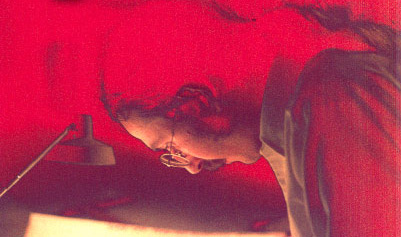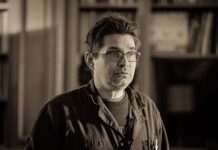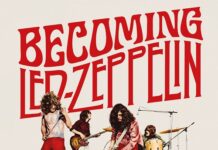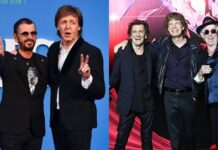Where do I start telling you about Moyssi?
Back in the day, he was a lighting designer working coast-to-coast in all the great rock and roll theaters and concert venues. In a career spanning 18 years and 2,000 shows, Moyssi designed and ran lights for the likes of New Riders of the Purple Sage, Foghat and Lou Reed. He also toured with the Jerry Garcia Band, which he claims was fun because, “as I remember it, they never actually toured…but simply gigged between Dead gigs.”
Though his personal favorite was the German trio Triumvirat (talk about the man’s versatility), Moyssi not only designed lighting but built rigs as well. He regards his lighting career as spanning a century because when he was working, LDs were using “19th century carbon arcs, 1000 W halogen PARs and colored gelatin — where today everything is cold light and computerized.”
While performing his lighting in New York and New Jersey (being mainly an east coast guy), Moyssi began to supplement his income by illustrating concert program covers for all concerts promoted by John Scher, one of the biggest promoters in the country at the time. Mr. Scher’s Capitol Theatre in Passaic, New Jersey, was named by Billboard Magazine in 1980 as the No.1 concert hall in the nation with under 6,000 seats (also my personal local rock venue in mid-to-late 70’s). This was where Moyssi was the resident stage lighting director and program designer.
He never truly viewed the programs as art — simply creative puzzles for the audience to enjoy. He claims almost every program cover was somehow directly connected to the performance, band bio, discography, and whatever else came to his mind. Audiences (like me who still have plenty of those arresting little Capitol programs) would try to figure out what the drawings meant in terms of the night’s performance. Mossyi admits sometimes the connection was very tenuous, while at other times so obvious that he’s slightly embarrassed by some of those covers now.
“One of my favorite illustrations was for the Rolling Stones in 1978,” he told me. This was a huge show for my area, and one that set my high school abuzz, seeing as the Stones hadn’t been around in a bit and were more or less playing indoor arenas on that tour. For Scher to have scored them for his 3,000 seat venue was big news indeed and a big deal for the resident lighting and program designer.
“They insisted on using their tour poster for our program cover,” Moyssi said. “So I put my front cover illustration, backwards, on the back cover. And I put a reference to every one of their 25 or so albums into that one drawing! It wasn’t fine art, but it was fun for everyone. I developed a unique style of line drawing which I call ‘manual moire’. It’s very fine work that is relevant to people who attended those shows or simply loved the music scene in the 70s and 80s.”
Certainly relevant to me, as my love for those programs and the Capitol put me onto Moyssi in the first place. He crossed the country working and while I did attempt to pin him down about the east coast vs. west coast vibe (and the promoters relative to each region at the time), he is quite diplomatic in his view.
“I chose to be a ‘resident’ lighting director for the important theatres in the NYMA and was a founding partner in a company that toured regionally on the East coast, so my actual touring experience was mostly to bring a crew out onto the road for the first two weeks of a tour and then head back to home. I view the E vs. W thing as more about the different styles in the early days.
“For example, the Grateful Dead had thousands of people dancing in the streets and parks of San Francisco, but that stuff was for free. And the weather was great except for the rainy season. Stony Brook University was their first paying gig on the East coast and that was exactly what the Dead were looking for to launch their career, so we were a natural for them. There is only one New York! At the time, all the creativity was here in New York while the acid was in San Francisco and the formulaic TV stuff that made money came from Los Angeles.”
During our conversation, I asked the man to go on record about who was the best live band he ever saw. He didn’t hesitate with an answer. “My take is that the Who is the best live rock band in the world, while the Dead are the best live jazz band on the world’s rock n’ roll stage.”
Seeing as Moyssi knows about lighting, and I’m a huge progressive rock fan very particular about staging, I began to bemoan missing the creativity of the really big arena show, inflatable pigs and costume changes from back in the day when they were so innovative. I know bands like Muse do their best to still deliver visually arresting shows and God knows U2 spends a ton of money; but for me there is something lost in all the modern-day computerization. I asked Moyssi what he thought.
“Unfortunately, as rock and roll descended into the vortex of big business, the art of lighting devolved into what I call ‘flash-a-beat rock,’ where poorly paid LDs so completely lacked imagination or creativity or spontaneity or artistic freedom that all they could do was to change the lights in time to the music ad infinitum. I like to think that they did that just to show creatively challenged managers that they were doing what they were asked to do. But you still had a living, breathing LD who could theoretically do something spontaneous and creative. Now computers seem to do everything, which to me is nothing less than a felony assault on the very essence of live musical performance.
“If you program or operate a computer to control the lights on a tour, you are a technician who executes a relatively isolated lighting designer’s choreography ad infinitum. Flash-a-beat rock on a magnificent scale, but still lacking in spontaneity. No serendipity at all. If you have to think on your feet all the time in real time, you are a performance artist limited only by your own talent. Back in the 60s and 70s and into the 80s, the lighting director was an artist who had complete creative control of the look and feel of every show, and every show was different.”
 What can I say to a guy who is speaking the gospel as far as I’m concerned? It makes me wonder how many unsung rock and roll heroes we have forgotten or never really knew — guys who ran light boards and took tickets at little local venues; local promoters who nearly went broke every time they managed to bribe a band like Black Oak Arkansas to come through town; guys like Moyssi who barely made a living trying to cobble together equipment that could barely see another show without overheating — people who loved the music so much they just wanted to be involved in some way.
What can I say to a guy who is speaking the gospel as far as I’m concerned? It makes me wonder how many unsung rock and roll heroes we have forgotten or never really knew — guys who ran light boards and took tickets at little local venues; local promoters who nearly went broke every time they managed to bribe a band like Black Oak Arkansas to come through town; guys like Moyssi who barely made a living trying to cobble together equipment that could barely see another show without overheating — people who loved the music so much they just wanted to be involved in some way.
The problem with talking to a guy like Moyssi is the stories can go on forever and I could sit and interview him all day. I couldn’t really, that wouldn’t have been fair (though he didn’t seem to be tiring of telling his stories), but I did eek out of him one last little anecdote he was especially proud of — a story that made me laugh out loud.
“After moyssi.com was finally launched, my colleagues from back in the day began to provide tons of photos and memorabilia and stories for me to publish along with my program cover for each show, and that is how moyssi.com became a focal point and a crossroads for people who loved the Capitol, Asbury Park, Roosevelt Stadium or any of the other places that we regularly worked. People tell me that it’s a great site. It gets a lot of visitors from all around the world, but it’s a kludge, technically speaking; I don’t have a shopping cart for my cover prints or even a guestbook, and it’s way overdue for a makeover. I’d like to recreate it and expand it to include historic material from all the great places that the Capitol crew worked. Still, it’s a monumental wealth of information and memories for those who haven’t yet wandered through.
“For most of my career in lighting, people would mistake me for Peter Yarrow, to whom I bear a startling resemblance. It was always fun being asked for an autograph or impressing a hot date by being waved into a NYC club without saying a word or showing a ticket or a pass — but even that got much better and more reliable when all the security guys came to know me in my position as LD so I could get waved in on my own face — so here’s the story:
“LIMHOF is the Long Island Music Hall of Fame, which was established a few years ago to honor the incredible musical talent that came from Long Island. Most famous Long Islanders would say they were from New York (Lou Reed, for example), so their Island home never became part of the collective consciousness. This is a pretty interesting and lively organization and more than a few of the directors in its first few years knew me personally and so I used to have a VIP invitation and just loved the red carpet and free wine.
“At the second induction ceremony, my wife and I were seated at the same table as Peter Yarrow, who was there either to accept the induction for someone else or as a presenter — I just can’t recall. As I passed all the photographers’ flashbulbs and made my way into the crowded hall — the Garden City Hotel I think it was — I heard this voice shouting, ‘Peter! Peter!’ somewhere behind me as my wife and I threaded ourselves through the dense crowd. When we finally arrived at our table, that fellow who kept calling out ‘Peter! Peter!’ reached out to me and touched my shoulder. When I turned around, he realized that I was not Peter Yarrow and I realized that he was Peter Tork of the Monkees, an amazingly energetic musician who still pushes the envelope.
“Anyway, Peter and I were seated at opposite sides of a table for 12, and people who approached the table to speak to Peter Yarrow almost invariably came to me first for the simple reason that, being about 10 years younger then he, I looked like their mind’s image of him. Actually, the fun part of this is that he and I met many years earlier while we were doing an outdoor show in New Jersey for John Scher. Peter came out of the hospitality tent just as I was approaching it. We passed each other about two feet apart and about 10 paces further on, both of us simultaneously turned around. He spoke first. He pointed his finger at me and said, “You’re the guy!” just as I realized how much the two of us did look alike. Well, it turns out that just as people mistook me for him, others mistook him for me. Now it’s really a gas to be mistaken for Peter Yarrow but I’ve always wondered how Peter Yarrow felt when he was mistaken for me!”




















